
The North State Street Historic District is a nationally designated historic district in Monticello, Piatt County, Illinois. The residential district is centered on State Street north of downtown Monticello; it includes 77 buildings, 56 of which are considered contributing to its historic character. The houses in the district represent the variety of architectural styles seen in Monticello from 1870 to 1948, the ages of the oldest and newest houses. The oldest houses in the district are designed in the Gothic Revival and Queen Anne styles. In the early 20th century, Monticello experienced an economic boom due to growth in agriculture and the local patent medicine industry; its newly wealthy residents built homes on State Street, which became known locally as "Millionaire's Row". The majority of these new homes had Colonial Revival designs, as the style was nationally popular at the time; Colonial Revival is still the district's predominant architectural style. Other designs featured in the district include Craftsman, Tudor Revival, and a Lustron house built in 1948. The district also includes several vernacular house types, such as the I-house and the bungalow.
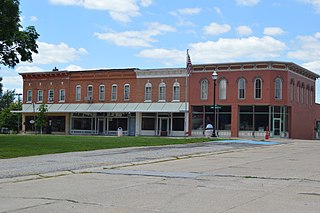
Barry Historic District is a historic district comprising the commercial and older residential areas of Barry, Pike County, Illinois. Barry was founded as an agricultural community in the 1830s, and most of its development took place between its founding and the Civil War. The city's commercial core, however, was mainly built in 1894 after a fire destroyed most of the existing commercial buildings. The 1894 buildings are well-preserved examples of typical commercial architecture of the period, and several have metal storefronts. The district also includes Barry's "Diamond Hill" residential district on Mortimer Street east of Brown Street and several other residential sections. Prominent architectural styles in the residential areas include Italianate, Queen Anne, Carpenter Gothic, and vernacular types from the late 19th century.

The Belleville Historic District is a historic district in Belleville, Illinois. The primarily residential district consists of an irregularly shaped area on the east side of Belleville. 70 buildings are included in the district, all of which are contributing buildings to its historic character. The homes in the district represent Belleville's residential development from 1830 to 1900. Many of the houses were designed in a vernacular cottage style popular among the city's German immigrants; while common in Belleville and other Metro-East cities, the style is little seen elsewhere in the state. Formal architectural styles such as Greek Revival and Italianate are also prevalent in the district.
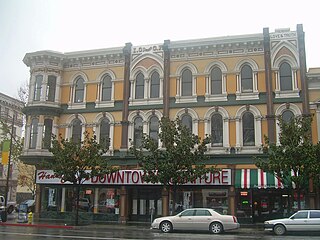
The Downtown Historic District of San Jose, California is a designated U.S. Historic District area of the city roughly the size of one square block. It is bounded by S. First Street to the west, E. San Fernando Street to the south, S. Third Street to the east, and E. Santa Clara Street to the north, but also includes the south side of E. Santa Clara Street between Third and Fourth Streets.
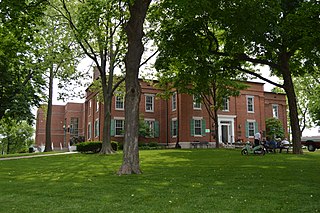
The Waterloo Historic District is a historic district composed of the majority of central Waterloo, Illinois. The district includes 271 buildings, of which 182 are contributing buildings to its historic character. The center of the district includes Waterloo's town square, the site of the Monroe County Courthouse, as well as a two-block section of Main Street which forms the city's commercial core. The town square is surrounded by residential development on three sides, an unusual arrangement among small towns in Illinois. The predominant architectural styles in the residential parts of the district are local adaptations of the Federal style and a German cottage style developed by the city's German immigrants in the 19th century.

Glenville Historic District, also known as Sherwood's Bridge, is a 33.9 acres (13.7 ha) historic district in the Glenville neighborhood of the town of Greenwich, Connecticut. It is the "most comprehensive example of a New England mill village within the Town of Greenwich". It "is also historically significant as one of the town's major staging areas of immigrants, predominantly Irish in the 19th century and Polish in the 20th century" and remains "the primary settlement of Poles in the town". Further, "[t]he district is architecturally significant because it contains two elaborate examples of mill construction, designed in the Romanesque Revival and a transitional Stick-style/Queen Anne; an excellent example of a Georgian Revival school; and notable examples of domestic and commercial architecture, including a Queen Anne mansion and an Italianate store building."

The Silver City Historic District is a historically significant section of downtown Silver City, New Mexico, United States.

The Morris Downtown Commercial Historic District is a historic district in downtown Morris. The district includes 116 buildings and a monument; 105 of these are commercial buildings, and 87 are contributing properties to the district.

The Petersburg Historic District is a historic district which includes most of Petersburg, Illinois. The district originally included 24 contributing buildings, the Oakland Cemetery, and a survey marker; the Smoot Hotel was later added to the district. The buildings in the district are a mixture of homes and commercial buildings. The earliest building in the district was built in 1826, while the latest were built in the 1890s. The Italianate style is the predominant architectural style in the district; other styles represented in the district include the Federal style in its early buildings, the Greek Revival style in buildings from the mid-1800s, and the Queen Anne style in buildings from the end of the century. Several of the sites in the district are associated with Abraham Lincoln; the survey marker marks the point where Lincoln began his survey of Petersburg, Ann Rutledge is buried in Oakland Cemetery, and residents of the other buildings included Lincoln's tutor and a gunsmith who operated out of Lincoln's New Salem store.

The Red Bud Historic District is a commercial and residential historic district which includes the originally developed portions of Red Bud, Illinois, United States. The district is centered on Main and Market Streets, the primary roads through the city. One hundred and ninety-five buildings and structures, including 138 contributing buildings, are included in the district. The oldest building in the district, the Greek Revival Durfee and Crozier Store, dates from 1855, seven years after Red Bud was platted. The community rapidly developed between the 1850s and 1880s, and architectural styles from these decades are prominently represented in the district. The Federal and Italianate styles are the two most prevalent in the district, the latter being an especially popular commercial design. Gothic Revival churches, Second Empire buildings, and a number of German-style cottages can also be found in the district. Development and population growth in Red Bud remained stable in Red Bud from the 1890s through most of the 20th century, and the historically developed core makes up most of the modern city.

The Logan Square Boulevards Historic District is a linear historic district in the Logan Square community area of North Side, Chicago. It encompasses 2.5 miles (4.0 km) of the Chicago boulevard system.
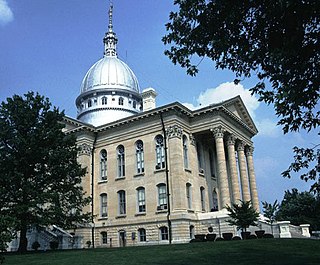
The Carlinville Historic District includes the oldest sections of Carlinville, Illinois. The district consists of much of central and eastern Carlinville and is roughly bounded by Oak Street, Mulberry Street, Morgan Street, and the eastern city limits. The Macoupin County Courthouse, a Beaux-Arts building built in 1867–70, is the focal point of the district. The courthouse is situated in a public square in downtown Carlinville and is surrounded by some of the city's oldest businesses. The district also includes large residential sections; popular architectural styles in these areas include Federal, Greek Revival, Italianate, and Queen Anne.
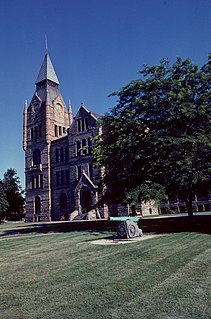
The Galesburg Historic District is a 496-acre (201 ha) historic district in Galesburg, Illinois. The district includes 1049 contributing buildings and contains the town's original plat as well as several older neighborhoods. The section of the district south of North Street encompasses Galesburg's historic city center and its most significant landmarks, such as the Knox County Courthouse, the Knox County Jail, the Burlington Depot, and Main Street's commercial buildings. Knox College, the school Galesburg was founded to serve, and its historic Old Main are also located in the southern half of the district. The area north of North Street is mainly residential and is dominated by Queen Anne and Classical Revival houses, including many transitional houses displaying elements of both styles.

The Jerseyville Downtown Historic District is a 17.5-acre (7.1 ha) historic district encompassing the commercial center of Jerseyville, Illinois. The district includes most of the city's historic commercial buildings, which were built along State Street and its cross streets from 1867 to 1929. The center of the district is at the intersection of State and Pearl Streets. The most prominent building in the district is the Jersey County Courthouse, a 124-foot tall limestone Romanesque Revival building built in 1893; unlike many other Illinois county seats, however, the district is not centered on the courthouse. The other buildings in the district are mainly one- and two-story brick Commercial style structures; other architectural influences in the district include Romanesque, Greek Revival, and Chateauesque. Other non-commercial buildings in the district include the Jerseyville Public Library, a Georgian style Carnegie library built in 1904, and the First Baptist Church, a Classical Revival church built in 1916.
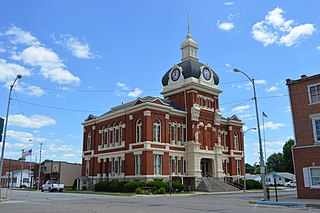
The Winchester Historic District is a historic district which encompasses much of the developed area of Winchester, Illinois. The district includes 438 buildings, of which 273 are contributing buildings. Winchester's historic area represents a typical small, rural county seat; its commercial development is focused around the county courthouse and town square, while low- to moderate-density residential development can be found away from the commercial center. Development in the district began in the 1830s; by the 1870s, most of the significant buildings had been completed. The district's older buildings are mainly designed in the Federal and Greek Revival styles, while its later buildings mostly have Italianate designs. The Greek Revival Presbyterian Church stands out among these traditionally-styled buildings; according to the Illinois Historic Structures Survey, it is the most exceptional Greek Revival church in any Illinois city of over 500 people. The Scott County Courthouse, a late addition to the district in 1885, has also been noted as architecturally significant, though its design does not conform to a single style.
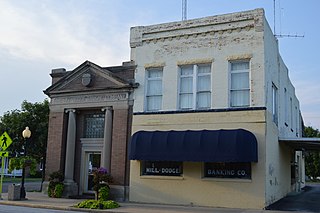
The Warsaw Historic District is a historic district encompassing the inner core of Warsaw, Hancock County, Illinois. As the city has lost many of its outlying residential areas, the district includes nearly all of the town's developed area, which has been relatively unchanged since the late 19th century. The city was settled in the 1810s and 1820s as a military outpost on the Mississippi River and was platted in 1833. As an economically significant port city, the town grew steadily until the 1870s, reaching a peak population of 5,000 to 15,000 people; it has declined since and now has less than 2,000 residents. The town's historic buildings include a commercial core along Main Street and low-density residential areas in the rest of the district. The Greek Revival, Federal, and Italianate architectural styles are all well-represented among the district's buildings.

Shelbyville Commercial Historic District is a national historic district located at Shelbyville, Shelby County, Indiana. The district encompasses 149 contributing buildings, 1 contributing site, and 2 contributing objects in the central business district of Shelbyville. It developed between about 1822 and the 1930s, and includes notable examples of Italianate, Second Empire, Beaux-Arts, Classical Revival, and Art Deco style architecture. Notable contributing resources include the Shelbyville Central Schools Administrative Offices (1912), Carnegie Library (1902), First Baptist Church (1903), St. Joseph Catholic Church and School (1908), Civic Center (1932), Melton Jewelry Store (1886), Blessing-Deprez Building (1869), Knights of Pythias (1901), Cherry Building (1889), I.O.O.F. Building (1895), Old High School Building (1886), and a statue of Charles Major (1929).

West Side Historic District is a national historic district located at Shelbyville, Shelby County, Indiana. The district encompasses 373 contributing buildings and 4 contributing structures in a predominantly residential section of Shelbyville. It developed between about 1853 and the 1939, and includes notable examples of Queen Anne, Colonial Revival, and Stick Style / Eastlake Movement style architecture. Located in the district is the separately listed John Hamilton House. Other notable buildings include the Peter Metzger House, Joseph Acre House, Earl Karmire House, Charles Davis House, Charles Birely House, Harry Whitcomb House, First Christian Church (1901), C.H. Campbell House, George McConnell House, First Presbyterian Church (1885), John Randall House, Alfred Major House, Frank C Sheldon House, and Edward Thurston House.
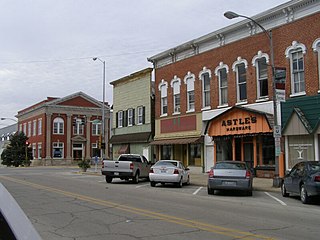
The Downtown Momence Historic District is a national historic district which encompasses the commercial core of downtown Momence, Illinois. The district includes 49 contributing buildings, all but two of which are commercial buildings; the remaining two are residential. While the oldest building in the district dates to 1849, significant development in downtown Momence did not begin until the Chicago, Danville and Vincennes Railroad reached the city in 1871. Roughly one-third of the district's buildings, primarily retail stores, were built between 1871 and 1900. Most of the remaining buildings were built between 1900 and 1930; these were more diverse and included banks, entertainment and recreational facilities, and automobile-related businesses toward the end of the period. The architectural styles seen in the district are representative of American commercial architectural trends of the late 19th and early 20th centuries; the majority of the buildings have Italianate designs, though examples of Greek Revival, Classical Revival, and Romanesque Revival architecture can also be found in the district.
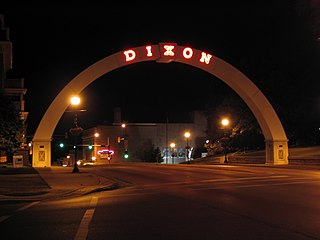
The Dixon Downtown Historic District is a historic district which encompasses 154 properties in downtown Dixon, Illinois. The district includes the city's commercial core, which includes buildings dating back to the 1850s. Dixon's commercial buildings are largely two-story brick structures and reflect the popular architectural styles of their era of construction; the Italianate style is most common in 19th-century buildings, while the Commercial style and revival styles such as Neoclassical and Beaux-Arts became popular after 1900. Many of Dixon's prominent government and community buildings also lie within the district, including the Lee County Courthouse, City Hall, its current and former post offices, and several churches. A residential section on the west side of the district includes Queen Anne and Craftsman style homes; the former style was popular in the late 19th century, while the latter was popular in the early 20th.






















